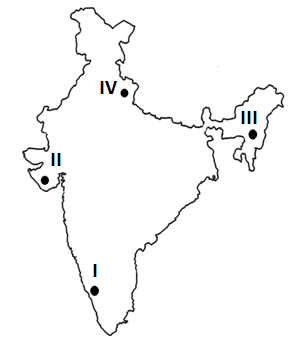
Match the National parks indicated on the map of India, (I, II, III, and IV) with their respective names.
A. Gir
B. Nagarhole
C. Jim Corbett
D. Kaziranga

A. I-C II- D III- A IV- B
B. I- A II- B III- C IV- D
C. I- B II- A III- D IV- C
D. I- D II- B III- C IV- A

Answer
456.3k+ views
Hint:National parks are protected areas where no or very little human interference is allowed. The National parks are for conservation purposes that are created to protect particular living species. They are made by National governments. There are a total of 104 National Parks in India.
Complete answer:
The National Parks provide natural and reliable habitats to endangered wildlife. The areas under National park are strictly reserved for the development and betterment of biodiversity. Activities like forestry, poaching, grazing, and hunting are not allowed in National parks. The boundaries of National parks are well marked by the State Government.

The Gir National park and wildlife sanctuary is a forest area designated as a National park. It is situated near Talala Gir in Gujarat. In the map, point II designates Gir National park.
The Nagarhole National park is a wildlife reserve. It is commonly known as Rajiv Gandhi National park. It is situated in the South Indian state of India called Karnataka. Point I in the map represents the Nagarhole National park.
Jim Corbett National park was established as Hailey National park in 1963 and it is the oldest National park in India. It aims to protect and preserve the endangered Bengal tiger. It is in the Nainital district of Uttarakhand. It is named after a well-known hunter and naturalist called Jim Corbett. Point IV represents the Jim Corbett National park.
Kaziranga National park aims at conserving the one-horned rhinoceros. It is situated in the Golaghat and Nagaon districts of Assam. Point III depicts the Kaziranga National park.
Hence, option C) is the right answer.
Note: National parks help in restoring the natural numbers of endangered species and should be supported by the people living near them. Increased human activities like poaching and hunting should be stopped to protect wildlife. Every species has a particular role to play in food chains. Thus, they should not be disturbed.
Complete answer:
The National Parks provide natural and reliable habitats to endangered wildlife. The areas under National park are strictly reserved for the development and betterment of biodiversity. Activities like forestry, poaching, grazing, and hunting are not allowed in National parks. The boundaries of National parks are well marked by the State Government.

The Gir National park and wildlife sanctuary is a forest area designated as a National park. It is situated near Talala Gir in Gujarat. In the map, point II designates Gir National park.
The Nagarhole National park is a wildlife reserve. It is commonly known as Rajiv Gandhi National park. It is situated in the South Indian state of India called Karnataka. Point I in the map represents the Nagarhole National park.
Jim Corbett National park was established as Hailey National park in 1963 and it is the oldest National park in India. It aims to protect and preserve the endangered Bengal tiger. It is in the Nainital district of Uttarakhand. It is named after a well-known hunter and naturalist called Jim Corbett. Point IV represents the Jim Corbett National park.
Kaziranga National park aims at conserving the one-horned rhinoceros. It is situated in the Golaghat and Nagaon districts of Assam. Point III depicts the Kaziranga National park.
Hence, option C) is the right answer.
Note: National parks help in restoring the natural numbers of endangered species and should be supported by the people living near them. Increased human activities like poaching and hunting should be stopped to protect wildlife. Every species has a particular role to play in food chains. Thus, they should not be disturbed.
Recently Updated Pages
Master Class 9 General Knowledge: Engaging Questions & Answers for Success

Master Class 9 English: Engaging Questions & Answers for Success

Master Class 9 Science: Engaging Questions & Answers for Success

Master Class 9 Social Science: Engaging Questions & Answers for Success

Master Class 9 Maths: Engaging Questions & Answers for Success

Class 9 Question and Answer - Your Ultimate Solutions Guide

Trending doubts
According to Bernoullis equation the expression which class 11 physics CBSE

Draw a diagram of nephron and explain its structur class 11 biology CBSE

Differentiate between calcination and roasting class 11 chemistry CBSE

A solution of a substance X is used for white washing class 11 chemistry CBSE

What is spore formation class 11 biology CBSE

10 examples of friction in our daily life




